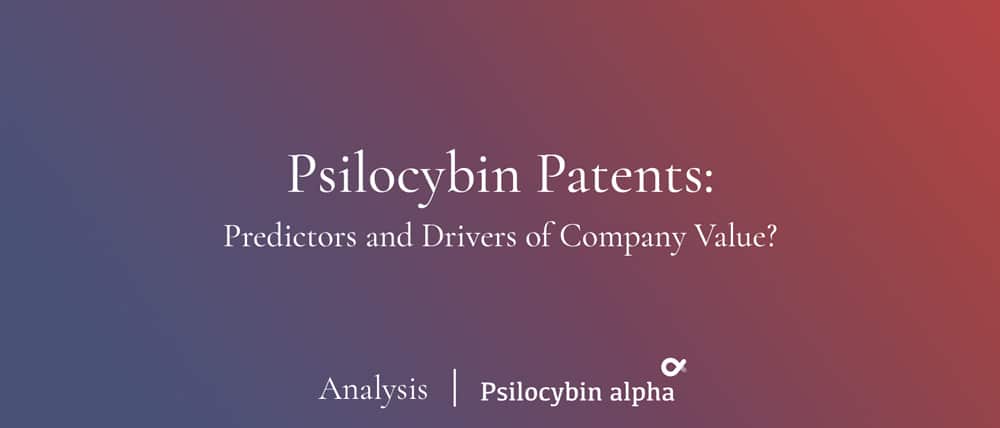Written by Graham Pechenik, editor-at-large. Follow Graham on Twitter.
Last updated: 18th November 2020
With COMPASS Pathways’ successful IPO, MindMed’s application to uplist to NASDAQ, and the ongoing surge of interest in the psychedelics space, we have to ask what’s driving value, and what can predict value as the space continues to unfold?
For many companies, the answer will be found in their patent portfolio. As COMPASS’ IPO prospectus explained: “We rely on patents and other intellectual property rights to protect our investigational COMP360 psilocybin therapy,” and on these “[o]ur commercial success depends.”
So who has filed the most patent applications, what applications are most likely to become granted patents, and what patents will have the broadest and strongest claims? And, how will these patent claims determine which companies are best positioned to take advantage of growth and investment in the sector? In the coming months, we will be turning to each of these questions, and considering them across the breadth of the entire psychedelics field.
We start by looking at patent activity related to psilocybin specifically, to help put COMPASS’ patents in context. It’s important to note that patent applications are kept secret for at least 18 months after filing. Thus, if press releases are anything to go by, we’ll be seeing this table expand dramatically next year—mushroom, if you will—as well over a dozen companies have recently announced psilocybin-related patent applications. These include Aion Therapeutic, Allied Corp., CB Therapeutics, Champignon Brands, Field Trip, Flourish Mushroom Labs, Frontier Neurochem, Lobe Sciences, MagicMed Industries, Mindset Pharma, Mydecine, NeonMind, Orthogonal Thinker, Psilera Bioscience, Revive Therapeutics, and Silo Pharma, among others. For now, none of these patent applications are public. You can browse these in our separate Psilocybin Patent Filing Tracker.
In our latest Psilocybin Alpha Data Bank release we’ve pulled together all of the published psilocybin-related patent applications and issued patents that were either filed in the U.S., or that later may be filed in the U.S. [1]. The applications and patents in the table include all those claiming psilocybin in a substantive way [2].
Visit the Psilocybin Patent Tracker
The first psilocybin-related patents were filed in 1958 and ’59 by Sandoz, with Albert Hofmann as an inventor. These claimed extraction of psilocybin from fungal material, and its use in crystalline form as a tranquilizer. Psilocybin-related patent activity thereafter lay mostly dormant until 2016, when Paul Stamets filed a provisional application on compositions including psilocybin, niacin, and other mushroom or cannabis extracts, and their use to treat neurological and mental health disorders. One notable exception in the intervening years is a 2010 application by Emory University, which was never issued as a patent, but was one of the earliest to include claims to psychedelic-assisted psychotherapy. Stamets’ provisional matured into three applications of which one was abandoned and two remain pending (both up on appeal).
COMPASS’ U.S. patent, when it issued on December 31st last year as U.S. Pat. No. 10,519,175, became the first issued patent directed toward psilocybin since Sandoz’s [3]. COMPASS’ ‘175 patent claims the treatment of drug resistant depression using a specific “polymorph” or crystalline form of psilocybin.
Since COMPASS’ patent, three additional patents have issued that cover psilocybin: one on “synaptic pathway training” using psilocybin; a second on cannabis oil nanoemulsions including psilocybin; and a third on treating psychological disorders with combinations of psilocybin, cannabinoids, and terpenes. An additional dozen have been published and remain pending—covering psilocybin compositions, formulations, methods of treatment, and methods of biosynthetic production. Applicants include CaaMTech, Eleusis, Akili, and several individuals, institutions, and pharmaceutical and nutraceutical companies. One application, that covers treating or preventing a mood disorder using compositions with psilocybin (as well as LSD, DMT, ayahuasca, and ketamine), was filed by Yale University and the U.S. Department of Veterans Affairs.
The full table of psilocybin-related patent applications and issued patents can be found here. Take a look now and then keep checking back—as we’ll update this table whenever new psilocybin applications become public, add new tables for other psychedelic compounds, and start to unpack the impact these applications and patents will have on companies and investments in the sector in articles to come.
Notes
Graham Pechenik is a registered patent attorney and the founder of Calyx Law, an IP boutique focusing on cannabis and psychedelics.
[1] A company may file a Patent Cooperation Treaty or “PCT” application—the ones starting with “WO” in the table—and then wait as long as 30 months before converting it into a U.S. application.
[2] Excepting merely incidental references to psilocybin, for example where it is included within a broad genus of compounds, or on a list of compounds that can come up on a patented drug test.
[3] A 2007 patent claimed improved production of psilocybin in genetically modified fungi, but only as one of a long list of compounds.


